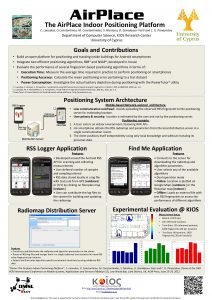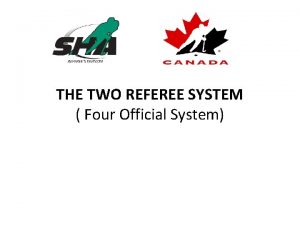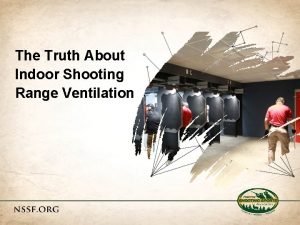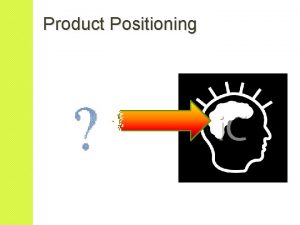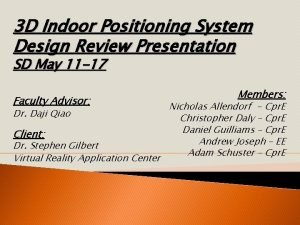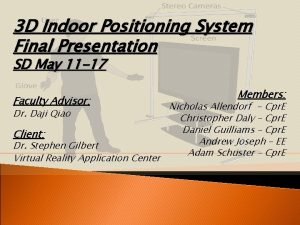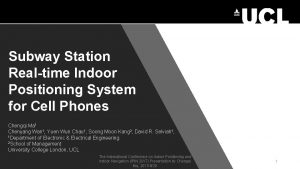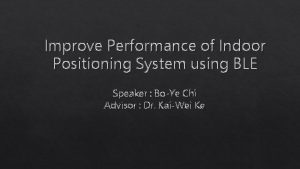3 D Indoor Positioning System SD May 11













- Slides: 13

3 D Indoor Positioning System SD May 11 -17 Faculty Advisor: Dr. Daji Qiao Client: Virtual Reality Application Center Members: Dan Guilliams – Cpr. E Nicholas Allendorf – Cpr. E Adam Schuster – Cpr. E Christopher Daly – Cpr. E Andrew Joseph – EE

Problem Statement • Currently, there exists no inexpensive system that is able to accurately localize object in threedimensional space. – We are concerned with small scale and high accuracy, unlike GPS. • Such a system could be used as an input device/controller to a computer system. – It could be used for virtual reality systems, touch tables, or a “Minority Report”-style UI. • Our goal is to create such a system, capable of tracking multiple objects.

Objective Design and build a 3 D indoor positioning system (IPS) for VRAC applications such as multi-touch table or touch wall. • • The end product is to provide fingertip tracking with 1 cm accuracy. • Two main components: • IPS Device: Worn on fingertips, or embedded in a glove • IPS Infrastructure: Detects location of IPS Devices

Conceptual System Diagram

Functional Decomposition (Modules) • Multiple, reproducible tracking devices • Tracking methods • • Received signal strength Infrared beacons and cameras Ultrasonic emitters Hybrid (Accelerometers and gyros paired with localization) • A minimum of 15 Hz refresh rate on position

Functional Requirements • Provide position updates with 1 cm accuracy within a 2 m x 2 m region indoors • Give position updates 15 times per second • Display position in a graphical interface • Support as many simultaneous devices as possible

Non-Functional Requirements • Small, lightweight device • Durable device • Device with long battery life (a few weeks) • Easy to set up infrastructure • Reproducible devices with consistent quality

Constraints • Small device size limits choice of technology • Need for battery life forces much of the work to be done by the infrastructure • Want the system to be as non-intrusive as possible (no annoying beeps or lights) • In order to distinguish devices, some part of the device must be distinguishable to infrastructure

Tenative Timeline

Risks and Mitigation • Finding the right technology for the task, need to do strong research and prototyping • Research needs to be completed on schedule so the project does not fall behind • Requirements are challenging and aiming for them could lead to coming up short, need to design the system such that there is room to give

Effort Estimates Name Research Design Implementation Testing Totals Chris Daly 30 40 140 Adam Schuster 30 40 140 Daniel Guilliams 30 40 140 Andrew Joseph 30 40 140 Nicholas Allendorf 30 40 140 150 200 700

Cost Estimate • Parts and materials: • Unknown at this time ~$1000 • Labor ($20/hr) • • • Chris Daly Adam Schuster Daniel Guilliams Andrew Joseph Nicholas Allendorf • Total $2800 $2800 ~$15000

 Indoor positioning platform
Indoor positioning platform Fall protection methods
Fall protection methods Arraytrack: a fine-grained indoor location system
Arraytrack: a fine-grained indoor location system Hci patterns
Hci patterns Hockey referee positioning 2 man system
Hockey referee positioning 2 man system Linesman hockey positioning
Linesman hockey positioning Remote sensing aphg
Remote sensing aphg Trbonet indoor
Trbonet indoor Portable indoor batting cages
Portable indoor batting cages Indoor and outdoor sports activities
Indoor and outdoor sports activities Outdoor games and indoor games
Outdoor games and indoor games Supplements for field hockey
Supplements for field hockey Specialty cottage indoor
Specialty cottage indoor Gun range ventilation
Gun range ventilation
